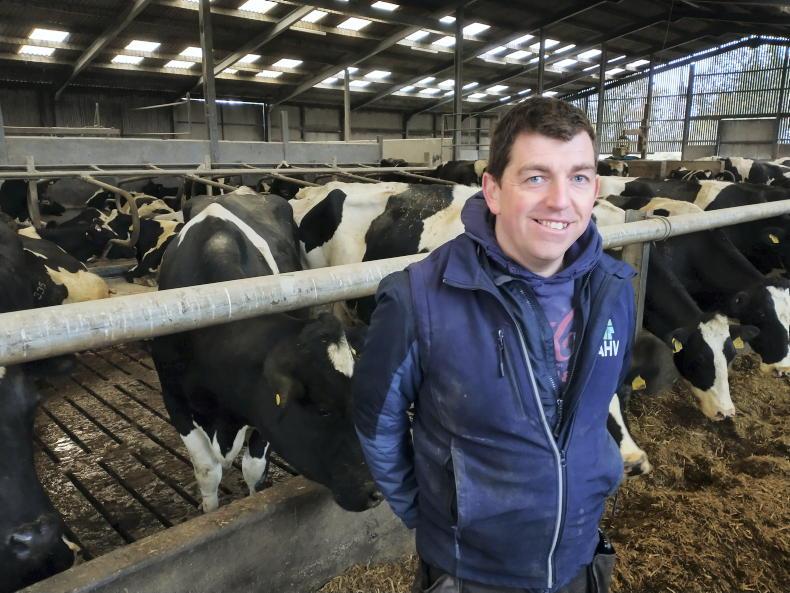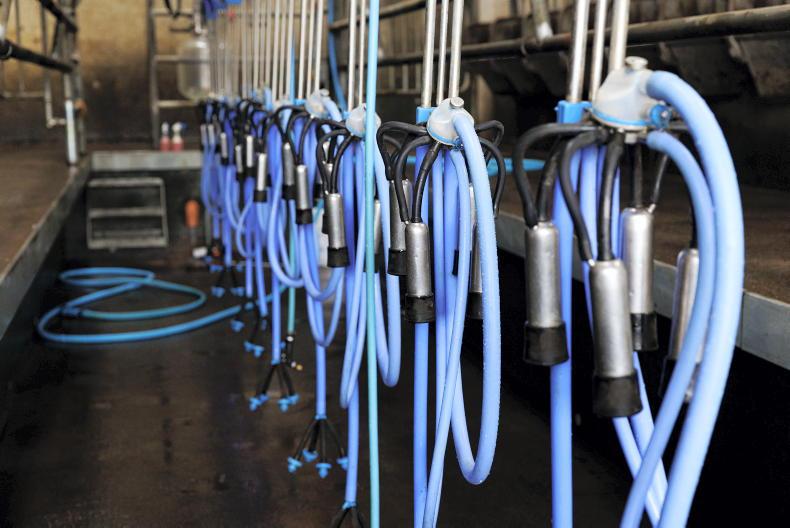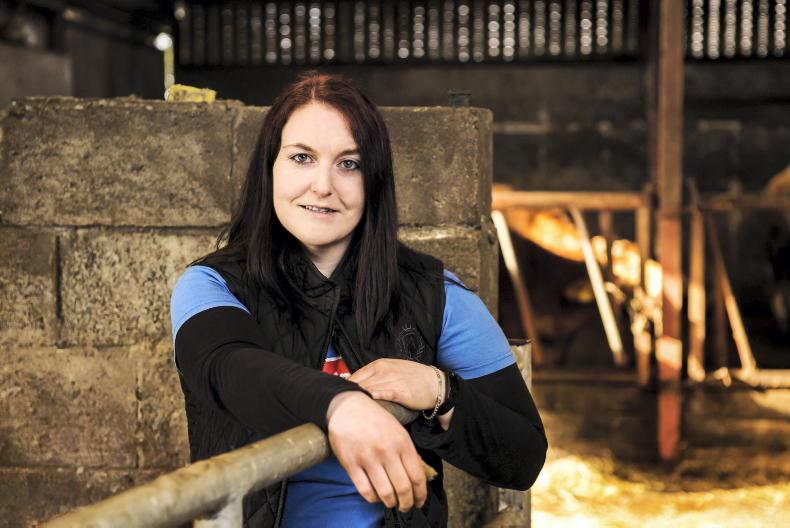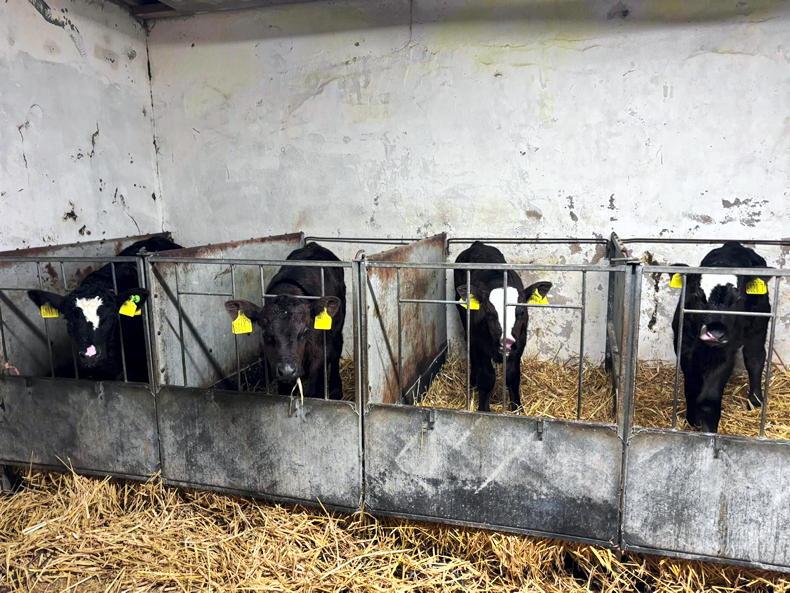Outside of a relief milker on a Sunday evening and some family help to move cows, feed calves, etc, Stephen Gibson operates as a single labour unit on the 100-cow Hollowbridge Farm outside Hillsborough in Co Down.
“I have no plans to expand. On this farm it is all about getting better, not bigger,” he told Dairylink participants on a visit to the Gibson farm last Thursday.
Stephen’s passion is for managing cows, not driving machinery, and he relies on a contractor for silage-making and the majority of his slurry work.
The herd is predominantly autumn calving, with 79% calved since the beginning of September, meaning that 83 are currently going through the parlour, leaving 22 dry cows and heifers still to calve by next February.
While there is scope to further tighten the calving period, like a lot of farmers in Northern Ireland (NI) Stephen believes that an autumn system best suits his farm. Freshly calved cows are kept in, and managed on a consistent diet. If conditions allow in the spring, he has cows settled in calf, past their peak of lactation, and suited to go to grass.
Poaching can be an issue in wet weather, but the farm also suffered during the droughts seen in two of the last three summers. “If those conditions persist in the future, it is another good reason to be autumn calving here,” suggests Stephen.
In 2020, the herd averaged 8,964l at 3.89% butterfat and 3.17% protein, on 2.75t of meal fed.
At present, cows are averaging 31.3l per cow at 4.1% butterfat and 3.17% protein. Overall yield and protein percentage are both currently down on what he had expected, but it is the legacy of an outbreak of winter dysentery, which eventually ran through a significant proportion of the milking herd in early autumn.
“It got to the point where I was nearly fearful of going out in the morning,” admits Stephen.

Stephen Gibson runs Hollowbridge Farm outside Hillsborough in Co Down.
Typified by a severe, dark brown diarrhoea, appetite is usually normal, but individual yields can be hit by up to 50%. Most cows recover in two to three days.
Exceptional silage
The figures from 2020 also show that Stephen produced 2,857l from forage alone. He believes there is scope to increase that further, with more work to be done to improve grazing infrastructure.
However, the key starting point is silage quality, and as shown in Table 1, he has exceptional first- and third-cut silage in store.
The first cut was harvested in early May, and an additive applied. A D-value of 79.8 equates to a DMD figure of approximately 86%.
Grassland is reseeded every eight to 10 years, and Stephen has utilised a soil programme offered via his processor, Lakeland Dairies, to match nutrients to crop needs, with advice provided by Grassland Agro.
When cows start calving in September they are on a total mixed ration (TMR) set at maintenance + 25l, with cows topped up in the parlour. With the herd now fully housed, the TMR is set at maintenance +19l (Table 2), with a 16% parlour nut fed to yield.
It is Stephen’s first year to include rye in the TMR, after it was offered to him by a local grower. His current thinking is that he will replace it with wholecrop next winter.
Technology demonstration farm
Stephen is a participant in CAFRE’s technology demonstration farm (TDF) project, with a particular focus on optimising feed efficiency.
While he has lots of analysis and information available to help drive feed efficiency, sometimes more mundane issues can make a big difference.
“I do see a lot of value in calibrating parlour feeders. Every time the feed mill changes the nut, I re-calibrate the feeders. I first noticed the issue when there was feed left over. Some of them were over-feeding by 30%,” he says.
That attention to detail also sees him measuring blood ketone levels 14 to 21 days after calving. Any cow with a reading of more than one on the tester gets a bolus. He has virtually eliminated sub-clinical cases of ketosis.
Breeding
Stephen also does his own AI work, and has a heat detection system in place to ease the process. He has used 100% sexed semen for the last three years, with late calvers put to beef bulls. All beef animals are finished on the farm.
Maiden heifers and first calvers were genomic tested this year. Stephen’s intention is to only breed replacements from animals that are genomic tested in the future (excluding those with low values). Bull selection is now targeting higher fat and protein.
Grass
Cows normally go to grass towards the end of March. After the second grazing onwards, Stephen pre-mows ahead of the cows. Grass in paddocks is measured weekly, and offered in 12-hour allocations.
“I want to continue to improve soil fertility, get more milk from forage, and breed functional cows with high milk solids and good fertility,” says Stephen.
Farm size: 76ha.Cow numbers: 100.Milk yield per cow: 8,964l.Meal fed per cow: 2.75t.Stocking rate: 2.35 CE/ha.Location:
Hillsborough,
Co Down Read more
Targeted sire selection pays dividends
Dairylink Ireland: feeding to yield in Co Armagh
Outside of a relief milker on a Sunday evening and some family help to move cows, feed calves, etc, Stephen Gibson operates as a single labour unit on the 100-cow Hollowbridge Farm outside Hillsborough in Co Down.
“I have no plans to expand. On this farm it is all about getting better, not bigger,” he told Dairylink participants on a visit to the Gibson farm last Thursday.
Stephen’s passion is for managing cows, not driving machinery, and he relies on a contractor for silage-making and the majority of his slurry work.
The herd is predominantly autumn calving, with 79% calved since the beginning of September, meaning that 83 are currently going through the parlour, leaving 22 dry cows and heifers still to calve by next February.
While there is scope to further tighten the calving period, like a lot of farmers in Northern Ireland (NI) Stephen believes that an autumn system best suits his farm. Freshly calved cows are kept in, and managed on a consistent diet. If conditions allow in the spring, he has cows settled in calf, past their peak of lactation, and suited to go to grass.
Poaching can be an issue in wet weather, but the farm also suffered during the droughts seen in two of the last three summers. “If those conditions persist in the future, it is another good reason to be autumn calving here,” suggests Stephen.
In 2020, the herd averaged 8,964l at 3.89% butterfat and 3.17% protein, on 2.75t of meal fed.
At present, cows are averaging 31.3l per cow at 4.1% butterfat and 3.17% protein. Overall yield and protein percentage are both currently down on what he had expected, but it is the legacy of an outbreak of winter dysentery, which eventually ran through a significant proportion of the milking herd in early autumn.
“It got to the point where I was nearly fearful of going out in the morning,” admits Stephen.

Stephen Gibson runs Hollowbridge Farm outside Hillsborough in Co Down.
Typified by a severe, dark brown diarrhoea, appetite is usually normal, but individual yields can be hit by up to 50%. Most cows recover in two to three days.
Exceptional silage
The figures from 2020 also show that Stephen produced 2,857l from forage alone. He believes there is scope to increase that further, with more work to be done to improve grazing infrastructure.
However, the key starting point is silage quality, and as shown in Table 1, he has exceptional first- and third-cut silage in store.
The first cut was harvested in early May, and an additive applied. A D-value of 79.8 equates to a DMD figure of approximately 86%.
Grassland is reseeded every eight to 10 years, and Stephen has utilised a soil programme offered via his processor, Lakeland Dairies, to match nutrients to crop needs, with advice provided by Grassland Agro.
When cows start calving in September they are on a total mixed ration (TMR) set at maintenance + 25l, with cows topped up in the parlour. With the herd now fully housed, the TMR is set at maintenance +19l (Table 2), with a 16% parlour nut fed to yield.
It is Stephen’s first year to include rye in the TMR, after it was offered to him by a local grower. His current thinking is that he will replace it with wholecrop next winter.
Technology demonstration farm
Stephen is a participant in CAFRE’s technology demonstration farm (TDF) project, with a particular focus on optimising feed efficiency.
While he has lots of analysis and information available to help drive feed efficiency, sometimes more mundane issues can make a big difference.
“I do see a lot of value in calibrating parlour feeders. Every time the feed mill changes the nut, I re-calibrate the feeders. I first noticed the issue when there was feed left over. Some of them were over-feeding by 30%,” he says.
That attention to detail also sees him measuring blood ketone levels 14 to 21 days after calving. Any cow with a reading of more than one on the tester gets a bolus. He has virtually eliminated sub-clinical cases of ketosis.
Breeding
Stephen also does his own AI work, and has a heat detection system in place to ease the process. He has used 100% sexed semen for the last three years, with late calvers put to beef bulls. All beef animals are finished on the farm.
Maiden heifers and first calvers were genomic tested this year. Stephen’s intention is to only breed replacements from animals that are genomic tested in the future (excluding those with low values). Bull selection is now targeting higher fat and protein.
Grass
Cows normally go to grass towards the end of March. After the second grazing onwards, Stephen pre-mows ahead of the cows. Grass in paddocks is measured weekly, and offered in 12-hour allocations.
“I want to continue to improve soil fertility, get more milk from forage, and breed functional cows with high milk solids and good fertility,” says Stephen.
Farm size: 76ha.Cow numbers: 100.Milk yield per cow: 8,964l.Meal fed per cow: 2.75t.Stocking rate: 2.35 CE/ha.Location:
Hillsborough,
Co Down Read more
Targeted sire selection pays dividends
Dairylink Ireland: feeding to yield in Co Armagh











SHARING OPTIONS